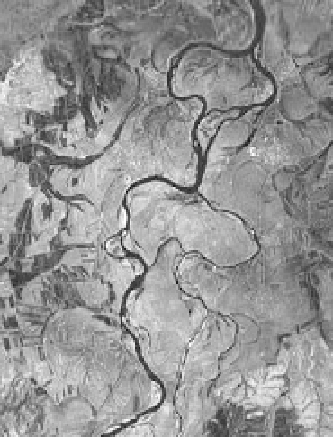Environmental Engineering Reference
In-Depth Information
5.3.5 Anastomosing Rivers
Anastomosing rivers are usually formed by avulsions, i.e., flow diversions that cause the formation of
new channels on the floodplain. As a product of avulsion, anastomosing rivers essentially form in two
ways:
ķ
by formation of bypasses, while bypassed older channel-belt segments remain active for some
period; and
ĸ
by splitting of the diverted flow, leading to contemporaneous scour of multiple channels
on the floodplain. Both genetic types of anastomosis may coexist in one river system, but whereas the
first may be a long-lived floodplain-wide phenomenon, the latter only represents a stage in the avulsion
process on a restricted part of the floodplain. Long-lived anastomosis is caused by frequent avulsions
and/or slow abandonment of old channels.
Avulsions (a kind of channel motion, which is discussed in Section 5.9.2) are primarily driven by
aggradation of the channel belt and/or loss of channel capacity by in-channel deposition. Both processes
are favored by a low floodplain gradient. Also of influence are a number of avulsion triggers such as
extreme floods, log and ice jams, and in-channel aeolian dunes. Although some of these triggers are
associated with a specific climate, the occurrence of anastomosis is not. A rapid rise of base level is
conductive to anastomosis, but is not a necessary condition.
An anastomosing river is not very stable. If one of the parallel channels is scoured deeper all water
may flow in this channel and abandon the others. Finally the anastomosing channels can change into a
single thread channel. The lower part of the abandoned channels remain connected with the main channel
and become channel-shape river connected lakes. Figure 5.50(a) shows the anastomosing channels of the
Mudan River in northeast China, in which the abandoned old channels are still visible. Figure 5.50(b)
shows the Hulan River near Harbin, which is a tributary of the Songhua River. The river had many
anastomosing channels, but now most of the channels have been abandoned. The main part of the river
has become a single thread, more or less meandering channel. The abandoned channels have separated or
remain connected with the river, and some of them have become isolated or river-connected lakes. These
lakes are different from the oxbow lakes resulting from development of a meandering river in shape and
origin. Ice jam floods may be the main cause for development of anastomosing rivers. As a river channel
(a) (b)
Fig. 5.50
(a) Anastomosing channels of the Mudanjiang River in northeast China; (b) The Hulan River near Harbin
was an anastomosing river with many channels and is now a single thread, more or less meandering channel; Many
isolated lakes are left after the anastomosing process









Search WWH ::

Custom Search